 | |
| Former names | Cardinal Stadium |
|---|---|
| Address | 4400 Martin Luther King, Jr. Parkway, Beaumont, Texas 77710 |
| Location | Beaumont, Texas |
| Coordinates | 30°2′35″N 94°4′12″W / 30.04306°N 94.07000°W |
| Owner | Lamar University |
| Operator | Lamar University |
| Executive suites | Presidential Suite: 25 seats Morgan Suites: 7 Suites with 16 seats each Montagne Center Red Room: Up to 75 |
| Capacity | 1964 (17,500) 2010 (16,000)[1] |
| Record attendance | 18,500 September 13, 1980 vs Baylor |
| Surface | |
| Scoreboard | SNA Displays 76'6" by 35'2" 10mm LED board Outer Frame 88' x 48'[5] |
| Construction | |
| Opened | 1964 |
| Renovated | 2010 |
| Construction cost | $1 million ($9.44 million in 2022 dollars[6]) $30 million (2010 Renovation) ($40.3 million in 2022 dollars[6]) |
| Architect | Renovation: Leo A. Daly[7] |
| Main contractors | Renovation: SETEX Construction Corp.[8] |
| Tenants | |
| Lamar Cardinals football (NCAA) | |
Provost Umphrey Stadium (previously Cardinal Stadium) is a 16,000-seat[9] multi-purpose stadium located on the campus of Lamar University in Beaumont, Texas. The stadium, home to the Lamar Cardinals football team, is located next to the Montagne Center. While primarily used for football, Provost Umphrey Stadium is also a concert venue with seating up to 20,000 for concerts.[10] The stadium was completely renovated in 2009 and is designed to allow for a future expansion to 28,000.[11]
Stadium features
Main seating areas
The stadium is configured in a predominantly northeast–southwest placement with two sides of seating. Entrance into the stadium is via one of four entrance gates located at the Southwest, Northwest, Southeast, and Northeast of the stadium. Ticket booths are located near the gates. Seating access to each of the stadium sides is provided at street level through a covered concourse. Concessions, six areas in total, as well as twelve rest room facilities are located in the concourse area. In addition, flat screen televisions are located throughout. Large photographic murals from games in the earlier days of the stadium are mounted on the concourse walls.
With the exception of the press box and chair back seating sections on the west side, each side of the stadium is basically a mirror image of the other. Each side is divided into two main levels with one level below street level and the other elevated. A street level outdoor concourse separates the two levels. A walkway on the south side of the stadium extends from each of the outdoor concourses and connects the two stadium sides providing easy pedestrian access from one side of the stadium to the other.
Additional seating
In addition to the two sides, the Morgan VIP suites located in the Montagne Center on the north end zone side of the stadium provide 112 seats (16 seats for each of the 7 suites). The Montagne Center Red Room, located above the VIP suites and overlooking the stadium, can accommodate up to 75 guests. Overflow attendance can be accommodated by large grassy areas located on both the north and south sides of the stadium. (Seating in the grassy areas is not included in the stated 16,000 stadium capacity.) The two southern porch sections of the Montagne Center also provide additional seating. Additionally, a presidential suite which can hold 25 is located in the press box. The presidential suite includes a kitchenette.
The outdoor concourses and south side walkway also contain a total of one hundred eight (108) chair-back seats as well as additional space for wheelchair seating. Each side has forty chair-back seats and additional space for wheelchair seating. In addition, the south side walkway includes twenty-eight (28) chair-back seats and wheelchair seating space. The seating sections were added as part of the stadium's complete renovation in 2009 and were part of stadium enhancements made to make the stadium compliant with the Americans with Disabilities Act of 1990.[12]
Press box
The two story press box, named the Dan F. and Sandra A. Smith Press Box, includes a media center with seating for 32; a TV broadcast booth; two radio broadcast booths; a kitchenette; restrooms; two camera decks; two coaches booths; scoreboard booth; public address booth; and private suites as well as the 25 seat presidential suite discussed above in the Additional seating section.[13] Press box access is via an elevator located at the rear of the press box and from west side seating.
Dauphin Athletic Complex
The two story Dauphin Athletic Complex, constructed in 2010, is located adjacent to the southern end of the stadium. The 54,000-square-foot (5,000 m2) complex includes an academic center; a 108-seat team auditorium; meeting rooms; locker rooms for both home and visiting teams; and offices for the athletic director, coaches, and other athletic department personnel. Also included is the J. B. Higgins Weight Room with 8,000 square feet (740 m2) of weight training space, three offices, a storage room, and media room. The university's main athletic training facility, The Beaumont Bone and Joint Institute Sports Medicine Facility, is also located in the complex. It includes a hydrotherapy pool with Hydroworx 1200 treadmill therapy pool, a plunge pool, electrical stimulation and ultrasound units, and a deep-penetrating vibration therapy device. The training facility is one of four on campus training facilities.[14]
Scoreboards
Mounted on top of the Dauphin Athletic Complex is the Education First Credit Union scoreboard. The scoreboard, installed in 2011, was replaced in 2023. The new video board, which "...measures 76'6" by 35'2" with over 2,700 square feet of LED lighting is 200 percent larger..."[5] than the former video board. The new SNA Displays board, with 10mm high-definition video, has the same footprint as the older board, 88' x 48'.[5] Another scoreboard is located near the base of the Morgan Suites on the northern end of the stadium.
Recap
- Presidential Suite - accommodating 25, with kitchenette
- Private suites - located in the press box (capacity not noted)
- Morgan VIP Suites - 7 (accommodating 16 each)
- Over 1,500 chair back seats with cup holders in the center sections of the west side
- ADA compliant seating - 108 chair back seats and wheel chair areas.
- Montagne Center Red Room - accommodates up to 75
- 54,000-square-foot (5,000 m2) athletic complex
- 76'6" by 35'2" SNA Displays[5] video board housed in an 88' X 48' outer frame
- Tarkett Fieldturf Classic HD CoolPlay turf[2] (replacing Hellas Matrix turf in 2021)[3]
- Six concession stands
- 12 restrooms
History
Cardinal Stadium, as it was originally known, was completed in 1964 for a cost of $1 million. The original stadium capacity was 17,500. The stadium was built as the home of the Lamar Cardinals football team. The football team was disbanded in 1989. Until plans to reinstate the Lamar Cardinal football program were finalized, the stadium hosted some Ozen High School football home games as well as the university soccer team for its first two seasons.
Presidential candidate, Barry Goldwater, spoke before an estimated 15,000-18,000 persons at the stadium on October 15, 1964.[15][16]
On September 19, 1998, the stadium played host to the 1998 Southern vs. Prairie View A&M football game as a "neutral ground" location.[17] The game was the final loss of 80 straight losses for the Prairie View program, but is more well known for a halftime brawl between the marching bands of the two schools resulting in a two-game suspension for both bands.[18] Southern won the game 37–7.[19]
In 2009 the university started renovation on the newly- named Provost Umphrey Stadium for the return of football in 2010.[20] Capacity was reduced to 16,000[1] in the 2010 renovation due to modifications in order to make the stadium ADA compliant. The modifications resulted in the loss of 1,500 seats. Provost Umphrey Stadium renovations and a new adjacent 54,000-square-foot (5,000 m2) athletic complex, detailed above, were completed for a combined total of $30 million. Another component of the stadium renovation included the addition of a new video board[21]
In July, 2021, the Hellas Matrix turf was replaced by Tarkett Fieldturf Classic HD Coolplay turf[2]
Donations and gifts
On November 10, 2008, the stadium became Provost Umphrey Stadium in recognition of a $3 million contribution to Lamar University from the Provost Umphrey law firm and an additional $1 million gift from Walter and Sheila Umphrey.[22]
On March 19, 2009, alumnus Dan F. Smith donated $6 million to the University, $1 million of which was earmarked for the return of football. In recognition of this gift the press box bears his name. The press box is detailed above in the Stadium Features section.[13]
On February 15, 2010 Education First Federal Credit Union donated $1 million to Lamar Athletics. In recognition for their support the 51' by 26' ft digital score board will permanently have Education First FCU displayed.[23]
On May 6, 2010, the Morgan Charitable Foundation on behalf of Glen and Teri Morgan donated an undisclosed amount of money to build the Morgan Suites on the south east side of the Montagne Center. Seven new suites were built and lease for $25,000 per year with a three-year commitment. The leases include 16 tickets to each home game and parking passes. Revenue from leasing the suites supports football scholarships. Each suite includes a bar with four stools overlooking two tiered rows of 6 seats each, a total of 16 seats. The suites open to the front and feature motorized windows that can be lowered as desired. Each suite includes a small refrigerator and cabinet space. Food and beverage service is available through the university catering vendor at additional charge.[24]
Attendance records
The largest crowd to see an Lamar Cardinal football game in Provost Umphrey Stadium was 18,500 on September 13, 1980, when the Cardinals hosted Baylor University.
Source:[25]
Below is a list of the Cardinals best-attended home games (all at Provost Umphrey Stadium). (Complete records not available for 1974-1981 and 1983–1989)
| Rk. | Date | Opponent | Attendance |
|---|---|---|---|
| Highest attendance | |||
| 1 | September 13, 1980 | Baylor | 18,500 |
| 2 | September 22, 1979 | Louisiana Tech | 17,600 |
| 3 | October 9, 2010 | Langston University | 17,306 |
| 4 | October 6, 1979 | West Texas State | 17,250 |
| 5 | September 17, 1977 | Louisiana-Lafayette | 17,222 |
| 6 | October 2, 2010 | Sam Houston State | 17,187 |
| 7 | September 11, 2010 | Webber International | 16,600 |
| 8 | October 16, 2010 | South Alabama | 16,150 |
| 9 | October 9, 1965 | Arkansas State | 16,000 |
| 10 | September 24, 1966 | Southwest Missouri | 15,643 |
| 11 | September 9, 1972 | Sam Houston State | 15,561 |
| 12 tie | September 3, 2011 | Texas College | 15,367 |
| 12 tie | September 17, 2011 | Incarnate Word | 15,367 |
| 12 tie | October 8, 2011 | Northwestern State | 15,367 |
| 12 tie | October 22, 2011 | Central Arkansas | 15,367 |
| 12 tie | September 8, 2012 | Prairie View A&M | 15,367 |
| 17 | October 2, 1965 | Pensacola Navy | 15,208 |
| 18 | October 11, 1970 | McNeese State | 15,165 |
| 19 | November 4, 1967 | Trinity | 15,153 |
| 20 | November 13, 2010 | South Dakota | 15,103 |
As of the 2023 season.
Yearly attendance
Below is the available home attendance since stadium opening in 1964.
| Season | Average | High |
|---|---|---|
| Lamar Cardinals | ||
| 2023[26] | 5,643 | 6,593 |
| 2022[26] | 5,069 | 6,627 |
| 2021[26] | 5,716 | 6,812 |
| 2020[26] | 3,293* | 3,833* |
| 2019[26] | 7,173 | 9,218 |
| 2018[26] | 7,077 | 8,028 |
| 2017[26] | 6,631 | 8,417 |
| 2016[26] | 7,429 | 8,697 |
| 2015[26] | 9,364 | 13,136 |
| 2014[26] | 8,347 | 10,212 |
| 2013[26] | 8,379 | 10,738 |
| 2012[26] | 11,119 | 15,367 |
| 2011[26] | 14,442 | 15,367 |
| 2010[26] | 16,078 | 17,306 |
| Program reinstated in 2010 | ||
| 1984-89 | Attendance missing or partial | |
| 1983[26] | 12,495 | 14,381 |
| 1982[26] | 7,856 | 13,330 |
| 1975-81 | Attendance missing or partial | |
| 1974[26] | 12,495 | 14,381 |
| 1973[26] | 10,565 | 13,220 |
| 1972[26] | 10,766 | 16,226 |
| 1971[26] | 11,428 | 13,220 |
| 1970[26] | 11,178 | 15,165 |
| 1969[26] | 11,177 | 13,747 |
| 1968[26] | 9,139 | 10,874 |
| 1967[26] | 13,087 | 15,153 |
| 1966[26] | 12,541 | 15,643 |
| 1965[26] | 12,560 | 16,000 |
| 1964[26] | 12,495 | 14,381 |
As of the 2023 season.
* Attendance restricted to 25% of stadium capacity due to COVID19 precautions
Gallery
- Views around the stadium
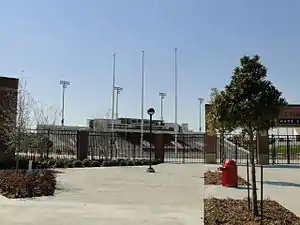 Visiting Entrance
Visiting Entrance View of east side seating
View of east side seating View of the west side seating
View of the west side seating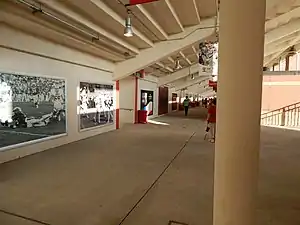 Murals on the concourse wall
Murals on the concourse wall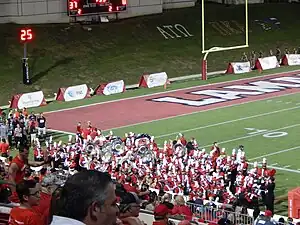 Toward the north end zone
Toward the north end zone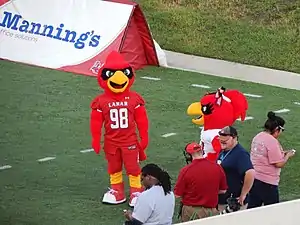 Big Red mascots before the game
Big Red mascots before the game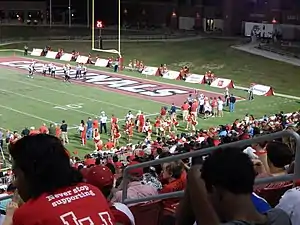 Toward the south end zone
Toward the south end zone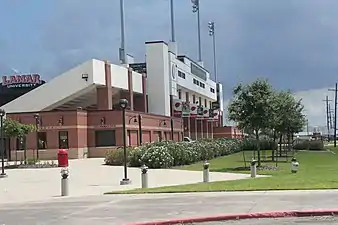 Provost Umphrey outside of stadium
Provost Umphrey outside of stadium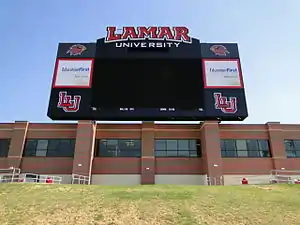 51' x 26' video display encased in 88' x 48' score board frame
51' x 26' video display encased in 88' x 48' score board frame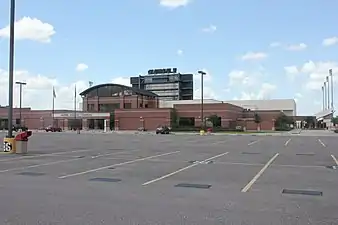 Dauphin Athletic Complex entrance
Dauphin Athletic Complex entrance Dauphin Athletic Complex and scoreboard from west side seating 30 minutes before game time
Dauphin Athletic Complex and scoreboard from west side seating 30 minutes before game time Morgan Suites and Montagne Center
Morgan Suites and Montagne Center
See also
References
- 1 2 "LAMARCARDINALS.COM - Lamar Cardinals Official Athletic Site - Facilities". Archived from the original on 2014-07-12. Retrieved 2010-08-18.
- 1 2 3 James Dixon (July 1, 2021). "Venues Get Upgrade as LU Begins WAC Journey". Lamar University Athletics. Retrieved December 24, 2021.
- 1 2 "Football Artificial Turf Project Underway - LAMARCARDINALS.COM - Lamar Cardinals Official Athletic Site". Archived from the original on 2014-07-15. Retrieved 2014-07-14.
- ↑ "Hellas Construction-Project Library". Hellas Construction. Retrieved June 5, 2020.
- 1 2 3 4 James Dixon (February 24, 2023). "Provost Umphrey Stadium Receiving Upgrades". Lamar University Athletics. Retrieved November 19, 2023.
- 1 2 1634–1699: McCusker, J. J. (1997). How Much Is That in Real Money? A Historical Price Index for Use as a Deflator of Money Values in the Economy of the United States: Addenda et Corrigenda (PDF). American Antiquarian Society. 1700–1799: McCusker, J. J. (1992). How Much Is That in Real Money? A Historical Price Index for Use as a Deflator of Money Values in the Economy of the United States (PDF). American Antiquarian Society. 1800–present: Federal Reserve Bank of Minneapolis. "Consumer Price Index (estimate) 1800–". Retrieved May 28, 2023.
- ↑ "Provost Umphrey Stadium Improvements and Athletic Complex". Leo A Daly. Retrieved September 2, 2015.
- ↑ "Lamar Provost Umphrey Stadium". SETEX Construction Corp. Retrieved June 27, 2016.
- ↑ "Provost Umphrey Stadium". Lamar University Athletics. Retrieved May 10, 2018.
- ↑ Facilities at MontagneEventCenter.com
- ↑ "Lamar University Athletics Releases Provost Umphrey Stadium drawings". Lamar University Athletics. May 7, 2010. Retrieved May 10, 2018.
- ↑ "Provost Umphrey Stadium Improvements and Athletic Complex Beaumont, Texas". Leo A Daly. Retrieved September 13, 2015.
The upgrade includes improvements to spectator amenities and concourses, modifications to seating areas to meet ADA requirements, and team training and athletic offices housed in a new south end zone building.
- 1 2 "Houston couple gives Lamar University engineering, football program $6 million gift". Lamar University. March 19, 2009. Retrieved May 10, 2018.
- ↑ "Lamar University 2014 Football Information Guide". Lamar University Athletics. 30 August 2014. Retrieved August 30, 2015.
- ↑ "Goldwater to Shun Jenkins Case But Not Its Aspects Of Security". The New York Times Company. October 16, 1964. Retrieved July 23, 2018.
In his Beaumont speech, before a crowd estimated at 15,000 ...
- ↑ "Enthusiastic Audience Welcomes Goldwater". The Redbird (Beaumont, TX). October 23, 1964. p. 1. Retrieved July 23, 2018.
An estimated crowd of more than 18,000 persons filled Cardinal Stadium to hear Sen. Barry Goldwater speak.
- ↑ "Battle of the bands goes too far". CNN/SI.com. September 20, 1998. Retrieved April 11, 2011.
- ↑ "SWAC Suspends PVAMU and SU Marching Bands". Onnidan.com. September 21, 1998. Retrieved April 11, 2011.
- ↑ DeLassus, David. "Coaching Records Game-by-Game, Greg Johnson (1998)". College Football Data Warehouse. Archived from the original on 25 May 2011. Retrieved April 11, 2011.
- ↑ "Cardinal Stadium reborn (Provost Umphrey)". Lamar.edu. Retrieved September 8, 2010.
- ↑ "Lamar University". Archived from the original on 2014-11-29. Retrieved 2014-07-23.
- ↑ "$4 million gift from law firm, couple prompts stadium naming". Lamar.edu. August 25, 2010. Retrieved September 8, 2010.
- ↑ "Education First FCU gives $1 million as sponsor of LU Athletics". Lamar.edu. Retrieved September 8, 2010.
- ↑ "Morgan Suites to enhance football complex". Lamar.edu. Retrieved September 8, 2010.
- ↑ http://grfx.cstv.com/photos/schools/lama/sports/m-footbl/auto_pdf/2012-13/misc_non_event/6-3-1.pdf
- 1 2 3 4 5 6 7 8 9 10 11 12 13 14 15 16 17 18 19 20 21 22 23 24 25 26 27 "NCAA Statistics - Lamar University Football History - Year by Year History". National Collegiate Athletic Association. Retrieved November 19, 2023.



